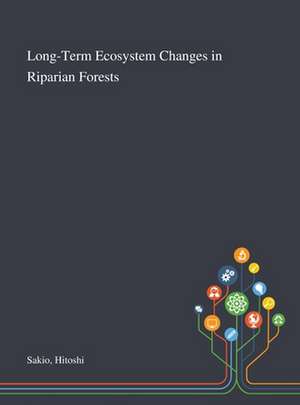Long-Term Ecosystem Changes in Riparian Forests
Autor Hitoshi Sakioen Limba Engleză Hardback – 8 oct 2020
| Toate formatele și edițiile | Preț | Express |
|---|---|---|
| Paperback (2) | 362.99 lei 38-44 zile | |
| Springer Nature Singapore – 18 sep 2020 | 362.99 lei 38-44 zile | |
| Saint Philip Street Press – 8 oct 2020 | 463.46 lei 38-44 zile | |
| Hardback (2) | 425.58 lei 6-8 săpt. | |
| Springer Nature Singapore – 20 mai 2020 | 425.58 lei 6-8 săpt. | |
| Saint Philip Street Press – 8 oct 2020 | 449.72 lei 38-44 zile |
Preț: 449.72 lei
Preț vechi: 555.20 lei
-19% Nou
Puncte Express: 675
Preț estimativ în valută:
86.05€ • 93.77$ • 72.51£
86.05€ • 93.77$ • 72.51£
Carte tipărită la comandă
Livrare economică 19-25 aprilie
Preluare comenzi: 021 569.72.76
Specificații
ISBN-13: 9781013277634
ISBN-10: 1013277635
Pagini: 232
Dimensiuni: 221 x 286 x 17 mm
Greutate: 0.83 kg
Editura: Saint Philip Street Press
ISBN-10: 1013277635
Pagini: 232
Dimensiuni: 221 x 286 x 17 mm
Greutate: 0.83 kg
Editura: Saint Philip Street Press
Cuprins
Part I. Introduction.- Chapter 1. The Ooyamazawa Riparian Forest: Introduction and Overview.- Part II. Life History and Regeneration Processes of Riparian Woody Species.-Chapter 2. Fraxinus platypoda.- Chapter 3. Pterocarya rhoifolia.- Chapter 4. Cercidiphyllum japonicum.- Chapter 5. Acer Tree Species.- Part III. Diversity and Coexistence in Riparian Forests.- Chapter 6. Diversity of Herbaceous Plants in the Ooyamazawa Riparian Forest.- Chapter 7. Coexistence of Tree Canopy Species.- Part IV. Ecosystem Changes in Riparian Forests.- Chapter 8. Changes in Forest Floor Vegetation.- Chapter 9. Temporal Changes in Browsing Damage by Sika Deer in a Natural Riparian Forest in Central Japan.- Chapter 10. Characteristics and Temporal Trends of a Ground Beetle (Coleoptera: Carabidae) Community in Ooyamazawa Riparian Forest.- Chapter 11. Avifauna at Ooyamazawa: Decline of Birds that Forage in Bushy Understories.- Part V. Conclusion.- Chapter 12. General Conclusion.
Notă biografică
Hitoshi Sakio is a Professor and Director of Sado Island Center for Ecological Sustainability, Niigata University in Niigata, Japan. He received his Ph.D. from Tokyo Metropolitan University, Japan. Hitoshi worked as a forest researcher in local government before moving to Niigata University. He is the leader of riparian forest research in Japan, and his teaching and research focus on forest ecology, especially riparian forest dynamics, tree life history, and alpine forest vegetation. He has published over 50 articles on field research in peer-reviewed journals, edited seven books and written 20 book chapters. He has received various honors for his outstanding contributions to research and education, including The Ecological Society of Japan’s 12th Oshima Award (2019) and The Japanese Forest Society Award (2019).
Textul de pe ultima copertă
This open access book presents and analyzes the results of more than 30 years of long-term ecological research in riparian forest ecosystems with the aim of casting light on changes in the dynamics of riparian forests over time. The research, focusing on the Ooyamazawa riparian forest, one of the remaining old-growth forests in Japan, has yielded a number of interesting outcomes. First, it shows that large-scale disturbances afford various trees opportunities for regeneration and are thus the driving force for the coexistence of canopy trees in riparian forests. Second, it identifies changes in reproductive patterns, highlighting that seed production has in fact quantitatively increased over the past two decades. Third, it describes the decline in forest floor vegetation caused by deer grazing and reveals how this decline has affected bird and insect populations. The book illustrates the interconnectedness of phenomena within an ecosystem and the resultant potential for cascade effects and also stresses the need for long-term ecological studies of climate change impacts on forests. It will be of interest to both professionals and academics in the field of forest science.
Caracteristici
Explains how trees can co-exist by analyzing the influences of large-scale disturbances on regeneration Highlights the need for long-term ecological studies of climate change impacts on forests Explains cascade effects within an ecosystem
